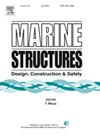Unexpected ice-induced vibrations of a conical structure in model scale
IF 5.1
2区 工程技术
Q1 ENGINEERING, CIVIL
引用次数: 0
Abstract
Offshore wind turbines in cold sea areas can be fitted with ice cones to reduce static and dynamic loads from drifting sea ice. The effectiveness of ice cones in reducing static loads has been tested in model-scale ice basin experiments. However, only a few experiments used compliant test setups to study ice-induced vibrations on conical structures. This study explores the dynamic interaction between level ice and a downward-bending cone with a 60° slope angle through ice basin tests with a hardware-in-the-loop system based on a hybrid technique, combining a physical indenter with a numerical structure model of an offshore wind turbine. Two types of periodic ice-induced vibrations were observed for the first time in an ice basin: bending failure-induced vibrations and unexpected vibrations caused by local failure at the ice-structure interface. The local failure had characteristics of both shear failure and crushing failure and occurred at low ice-structure interaction speeds during tests. Local failure-induced vibrations were significant in the dynamic test with an ice-drift speed of 5 mm s-1, however they also contributed to the dynamic response of the structure at higher ice-drift speeds. Bending failure-induced vibrations occurred at critical ice-drift speeds (30 mm s-1 to 40 mm s-1 and 70 mm s-1 to 100 mm s-1) where the bending failure frequency matched the 1st or 2nd natural frequency of the structure model. The results show that ice-induced vibrations on conical structures occur at various ice-drift velocities for both previously known and unexpected ice failure modes. Furthermore, the results provide new insight into conducting ice basin tests on ice-structure interaction with compliant conical structures.
模型尺度下锥形结构的意外冰激振动
寒冷海域的海上风力涡轮机可以安装冰锥,以减少海冰漂移带来的静、动载荷。冰锥减小静载荷的有效性已在模型尺度冰盆试验中得到验证。然而,只有少数实验使用了柔性测试装置来研究锥形结构的冰激振动。本研究利用基于混合技术的硬件在环系统,结合物理压头和海上风力发电机的数值结构模型,通过冰盆试验,探索了水平冰与60°坡角下弯锥体之间的动态相互作用。首次在冰盆中观测到两种类型的周期性冰激振动:弯曲破坏诱发振动和冰-结构界面局部破坏引起的非预期振动。局部破坏具有剪切破坏和破碎破坏的双重特征,且发生在低冰-结构相互作用速度下。当冰漂速度为5 mm s-1时,局部破坏诱发振动显著,但在更高的冰漂速度下,局部破坏诱发振动对结构的动力响应也有影响。弯曲破坏诱发振动发生在临界冰漂速度(30 mm s-1 ~ 40 mm s-1和70 mm s-1 ~ 100 mm s-1)下,弯曲破坏频率与结构模型的第一或第二固有频率相匹配。结果表明,圆锥结构的冰激振动在不同的冰漂速度下发生,无论是已知的冰破坏模式还是未知的冰破坏模式。此外,研究结果为冰-结构与柔性锥形结构相互作用的冰盆试验提供了新的见解。
本文章由计算机程序翻译,如有差异,请以英文原文为准。
求助全文
约1分钟内获得全文
求助全文
来源期刊

Marine Structures
工程技术-工程:海洋
CiteScore
8.70
自引率
7.70%
发文量
157
审稿时长
6.4 months
期刊介绍:
This journal aims to provide a medium for presentation and discussion of the latest developments in research, design, fabrication and in-service experience relating to marine structures, i.e., all structures of steel, concrete, light alloy or composite construction having an interface with the sea, including ships, fixed and mobile offshore platforms, submarine and submersibles, pipelines, subsea systems for shallow and deep ocean operations and coastal structures such as piers.
 求助内容:
求助内容: 应助结果提醒方式:
应助结果提醒方式:


